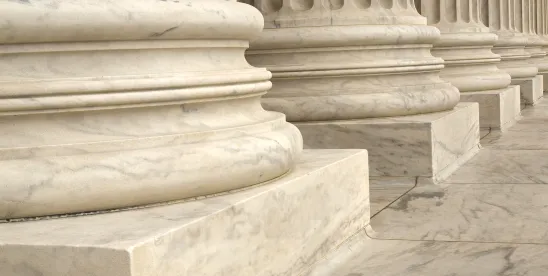In general, courts—not the legislative or executive branches of government—interpret the law. But since 1984, the Supreme Court required federal courts to disregard their own interpretation of ambiguous federal statutes.
Under Chevron, U.S.A., Inc. v. Natural Resource Defense Council, 467 U.S. 837 (1984), federal courts had to defer to a federal agency’s interpretation of any ambiguous statute within the agency’s purview, even if the agency’s interpretation of federal law didn’t align with the courts. That practice stopped last month with the Court’s decision in Loper Bright Enterprises v. Raimondo, No. 22-451 (decided June 28, 2024). This article examines the Chevron doctrine, why the Court rejected it after 40 years, and what businesses and other regulated parties can expect now that Chevron is a thing of the past.
The Chevron Doctrine: an Overview
Chevron started out simply enough. When a regulated party challenged an agency’s interpretation of an ambiguous statute, the decision required courts to defer to the responsible agency’s interpretation so long as it was reasonable. Chevron thus set out a two-step framework to determine when deference was appropriate.
First, a reviewing court would determine whether the statute at issue was ambiguous. If it was not, then the Chevron inquiry ended, and the court was to construe the statute according to its plain meaning.
Second, if the statute was ambiguous, the court evaluated the agency’s interpretation. If the agency’s interpretation was “reasonable,” the reviewing court had to give that interpretation binding deference, whether or not the court felt that the agency’s construction was the best reading of the statute.
Over time, Chevron became more complex. For example, more than 20 years ago, the Court recognized what became known as Chevron “step zero,” which required reviewing courts to determine whether Congress had intended to allow agencies to fill gaps in ambiguous statutes. See United States v. Mead Corp., 533 U.S. 218, 304–05 (2001). In many cases, satisfying step zero required a reviewing court only to determine whether Congress had made an express delegation. In some, however, the reviewing court was left to assess the overall statutory framework to determine whether deference to an agency’s interpretation might be appropriate.
Step zero was just the beginning. Eventually, the Supreme Court also developed the so-called “major questions” doctrine, which exempted questions of “deep ‘economic and political significance’” from Chevron’s ambit. King v. Burwell, 576 U.S. 473, 486 (2015). In those situations, the Court concluded that Congress had to delegate interpretative authority to agencies “expressly.” Id. Beyond step zero and the major-questions doctrine, the Court has also refused to apply Chevron to agency interpretations of judicial review provisions and statutory scheme’s outside of an agency’s purview. Epic Sys. Corp. v. Lewis, 584 U.S. 497, 519–20 (2018); Adams Fruit Co. v. Barrett, 494 U.S. 638, 649–50 (1990).
While all this may sound technical, the Chevron decision had enormous consequences. A substantial number of federal policies—including environmental, energy, education, consumer protection, and even tax policies—have been enacted by federal administrative agencies relying on Chevron.
Loper Bright Enterprises v. Raimondo and the Demise of Chevron
In Loper Bright, the petitioners had initially asked whether the Magnuson–Stevens Fishery Conservation and Management Act, 16 U.S.C. § 1801, authorized the National Marine Fisheries Service to compel certain Atlantic herring fisherman to carry federally-mandated “observers” and to bear the costs associated with such observers. By the time the case made its way to the Supreme Court, however, the question had been limited to whether Chevron should be overruled.
Chief Justice John G. Roberts, Jr., wrote the opinion overruling Chevron. He was joined by Justices Thomas, Alito, Gorsuch, Kavanaugh, and Barrett, overruled Chevron.
The Court’s opinion highlighted three major concerns to support its conclusion:
First, the Court determined that Chevron was an abdication of judicial responsibility. The Court reaffirmed that Article III of the Constitution assigns to the judiciary the responsibility to interpret laws. The Framers intended that courts, not agencies, would have the final say in statutory interpretation, a principle underscored in the landmark case Marbury v. Madison.
Second, the Court decided that Chevron conflicted with established historical practice. The opinion traced the historical understanding of judicial review, noting that while courts have traditionally given respectful consideration to executive interpretations, they have not relinquished their duty to independently interpret the law. The Court emphasized that even during the New Deal era, when administrative agencies proliferated, courts maintained their role in statutory interpretation.
Finally, the Court concluded that Chevron went against the Administrative Procedure Act (APA), 5 U.S.C. § 706, the statute that allows regulated parties to challenge agency action. The Court highlighted that the APA codifies the principle that courts decide all relevant questions of law and do not defer to agency interpretations of statutes. The APA specifies that courts must interpret constitutional and statutory provisions independently, without a deferential standard for ambiguous laws.
Where do we go from here?
Overruling Chevron was a major change in administrative law, which may leave many federal policies open to challenge. For example:
- The United States Environmental Protection Agency (EPA) has been a frequent defendant in Chevron-related cases. For years, EPA has been trying to modernize environmental regulations, particular those promulgated under the Clean Air Act and Clean Water Act. Most recently, the Supreme Court struck down the EPA’s Clean Power Plan under the Clean Air Act, using the major-questions doctrine to determine that the Plan contradicted the Act. See West Virginia v. EPA, No. 20-1530, 597 U.S. ___ (2022). Future efforts by the EPA to regulate emissions may be further stymied by the Court’s decision in Loper Bright.
- The United States Department of Education recently overhauled the regulations interpreting Title IX, the federal statute that prohibits discrimination in education on the basis of sex. An amicus (or “friend of the court”) brief filed in Loper Bright shows that some advocacy group view Chevron as the Biden administration’s only justification for expanding the interpretation of “sex” under Title IX. See of Christina Employers Alliance as Amicus Curiae Supporting Pets. at *25–28, Loper Bright Enters.v. Raimondo, No. 22-451.
- A federal judge in Texas recently enjoined the United States Department of Labor’s attempt to increase the salary required to satisfy the executive, administrative, and professional employee exemption to the Fair Labor Standards Act (FLSA). See Texas v. Dep’t of Labor, No. 4:24-CV-499 (E.D. Tex. June 28, 2024) (ECF No. 38). The Biden administration had attempted to increase the minimum wage necessary to exempt executive, administrative, and professional employees from overtime pay, thus extending the FLSA’s overtime protections to new employees. Applying Loper Bright, the court determined that the administration’s plans deviated from the FLSA’s text.
Loper Bright could impact several other regulated areas, including financial services (e.g., the Consumer Financial Protection Bureau) and telecommunications (e.g., the Federal Communications Commission). Only time will tell.
Although the Court’s decision in Loper Bright will have consequences, it is not without guardrails. For example, despite jettisoning mandatory agency deference, the Court reaffirmed its earlier decision in Skidmore v. Swift & Co., 323 U.S. 134 (1944), which allows federal courts to defer to an agency’s interpretation of an ambiguous federal statute when the agency’s reading of the statute is persuasive. The Court’s decision to explicitly acknowledge Skidmore means that, in extremely technical fields, reviewing courts likely will continue to adopt the relevant agency’s interpretation of a statute, but they are no longer required to do so. The Court also mentioned that some statutes expressly delegate decision making power to agencies—or at least allow them to prescribe rules that flesh out the details of a particular statute’s construction and operation. Presumably, under Loper Bright, such delegations will remain viable.
Conclusion
The Supreme Court's decision in Loper Bright Enterprises v. Raimondo is a watershed moment in administrative law. By overruling the Chevron doctrine, the Court reasserted the judiciary's role in interpreting statutes and ensuring that agencies act within their statutory mandates. This decision will reshape the landscape of judicial review and agency accountability, with far-reaching implications for the regulatory environment and the balance of power between the judiciary and administrative agencies. As courts and agencies navigate this new terrain, the principles of independent judicial judgment and statutory interpretation will take center stage, guiding the future of administrative law in the United States.




 />i
/>i
